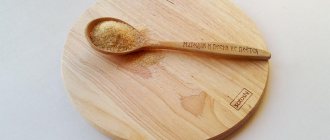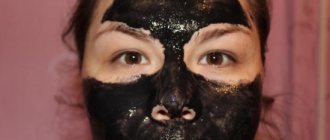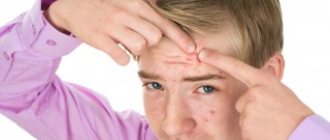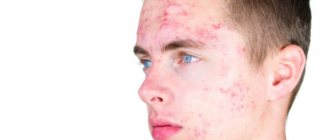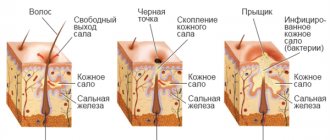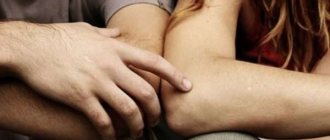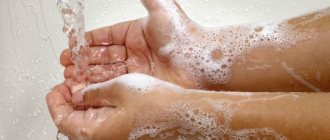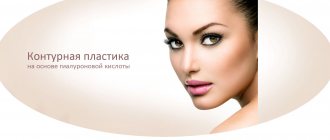Possible causes of red rash
There are many reasons for the appearance of red rashes on the face. The most common of them:
- allergic reaction to food, cosmetics, medications;
- a peculiar reaction of the skin to temperature changes;
- vascular diseases;
- hormonal dysfunctions;
- insect bites;
- some infections - rubella, measles, scarlet fever, chicken pox;
- various disorders of the internal organs.
If a rash on the face in the form of red spots in adults appears suddenly, this may indicate the development of an allergic reaction. Only an allergist can determine where the allergen comes from.
Note! Allergies are usually accompanied by itching and swelling. An allergy rash may appear on the neck and upper chest.
Allergic rash
Reddish pimples as a result of hormonal imbalance occur in adolescents. They are also common in women during the cessation of menstruation. This rash may be itchy.
If profuse rashes appear on the skin of the face, and this process is accompanied by itching, chills, nausea, and fever, then the person is likely to develop an infectious disease. These symptoms also occur in newborns.
One of the most common pathologies of capillaries is rosacea. Often occurs in men. With rosacea, blood vessels have increased fragility. The appearance of small red pimples on the face of an adult is recorded on the nose, chin, cheekbones, and less often on the head. If the vessels grow, angiomas appear on the face. They look like a raised red rash.
Carefully! If the angioma is accidentally injured, severe bleeding may develop.
Finally, small red spots may appear around the eyes. They appear when coughing or straining. The appearance of a subcutaneous rash on the face is characteristic of a large number of connective tissue pathologies and bleeding disorders.
Economics of Pharmacy Organization of Pharmacy Activities
The first thing we pay attention to when meeting or getting to know a person is his face. Some doctors examine the skin of the face to assess the patient's condition.When examining the skin, its condition is assessed. Indeed, the skin of the face is connected with the work of internal organs.
The condition of the internal organs can be indicated by skin color, moisture, wrinkles, and vascular patterns. If the functioning of any organ is disrupted, then a rash will appear on the area of the person corresponding to this organ.
Dermatologists know that skin problems not related to internal disorders occur in 5% of cases. Facial skin as an indicator of the state of the body.
For example, in case of kidney problems, acne and swelling may appear on the face. Each part of the face is responsible for some organ.
Let's take a closer look at how to identify a particular disease by looking at the face.
The forehead carries information about the intestines. The upper part is responsible for the large intestine, the lower area of the forehead will tell you about the condition of the small intestine. The hairline is a projection of bladder problems. Bladder problems can also appear on the lower part of the chin and in the area that runs towards the neck.
At the temples there is an area of the gallbladder. If it does not work properly, acne appears on the temples, red spots on the skin, and headaches occur in the temporal region. In addition, in some cases, yellowing of the skin occurs. Acute and chronic disorders in the gallbladder may be accompanied by yellowness of the sclera of the eyes.
Deviations in liver function appear in the area between the eyebrows . Dysfunction of the jaw joints can be observed in chronic liver diseases. At the initial stage of the disease, pain appears on palpation. In some cases, liver disorders are accompanied by redness of the sclera and blurred vision.
The cheeks represent the projection of the human lungs. The right cheek carries information about the right lung, the left cheek - about the left. Impaired lung function is accompanied by the appearance of a vascular pattern and persistent redness. The protruding part of the cheek follows the shape of the lung. The upper part of the cheek is the top of the lung, and the lower part is the bottom of the lung.
The respiratory system is also projected onto the wings of the nose. Problems with the bronchi appear in this area. People suffering from bronchitis often experience redness on the wings of the nose, as well as pimples and large pores. At the tip of the nose, disturbances in the functioning of the heart appear, namely arrhythmia.
In the upper part of the left cheek, cardiac disorders are expressed by the appearance of a red spot.
Blue lips indicate impaired blood flow and heart function . A bluish nasolabial triangle is a very dangerous signal, indicating a pre-infarction condition, heart failure or a cardiac septal defect.
Painful sensations when pressing on the eyebrows also indicate cardiac dysfunction. Redness, darkening, or swelling of the area around the eyes may indicate kidney problems. Papillomas around the eyes indicate congestion, stones or cysts.
The bridge of the nose is an area that projects disorders of the pancreas and stomach. The chin informs about the state of the human reproductive system. In women, disorders in the appendages and ovaries are accompanied by the appearance of acne and redness on the chin. In men, such signs indicate the development of prostatitis or its presence.
Of course, any doctor will not diagnose you based on the signs on your facial skin. But they can help confirm the diagnosis. These signs may serve as a signal to consult a doctor in a timely manner.
How to get rid of red dots
When red spots appear, salon procedures and home remedies are used.
Salon treatments
Against facial skin rashes in the form of red spots in adults, these salon procedures are the most effective.
Cryodestruction
This is the name of the effect on the skin using liquid nitrogen. It has a very low boiling point - minus 196 degrees. Cells die when frozen due to rapid dehydration and membrane damage.
During destruction, a feeling of discomfort, tingling, and slight burning may occur. Complete rejection of dead cells occurs within 2 weeks, sometimes within a month.
The procedure is not performed in the presence of inflammatory skin processes.
Ozone therapy
These are injections of ozone into the skin. The procedure stimulates blood circulation and lymph outflow. Injections also help with the appearance of a rash. Ozone speeds up metabolism, quickly heals affected areas of the skin, and prevents redness. After ozone, the face takes on a healthy and well-groomed appearance.
Ozone is injected into the skin using a very thin needle. After the injection, a massage is given. Recently, special foams enriched with ozone have begun to be used. This method is often practiced in the treatment of pathologically dilated vessels.
Electrocoagulation
This is cauterization of an element of the rash using a needle electrode. A high frequency electric current acts on the tissue around the rash element. As a result, the treated area of skin becomes crusty and soon falls off. In some cases it may burst.
Electrocoagulation
In most cases, the procedure does not cause significant pain. For patients with a low pain threshold, anesthesia is prescribed. The total duration of the procedure is no more than 15 minutes.
Laser treatment
The laser beam can remove red spots on the face quickly and painlessly. During the procedure, the tissue is heated. The rash element is removed under high temperature. The scars begin to fade within a few days.
Laser treatment has minimal side effects and is virtually painless. Only some patients may feel minor discomfort. The consequences of laser removal of red spots are skin rejuvenation and tone alignment. The rehabilitation period after the procedure is about 7 days.
Diathermocoagulation
During this procedure, often used in dental practice, tissue is cauterized with high-precision alternating current. Coagulation of tissues and blood vessels occurs due to the targeted effect of high temperature. This intervention is not painful.
Medications
They are used mainly in the treatment of allergic diseases. Some of them are even prescribed to infants. To remove acne, the doctor recommends taking antihistamines such as Tavegil, Suprastin, Loratadine. Medicines are available in the form of tablets, ointments, and pastes.
Allergy cream
In some cases, the doctor prescribes hormonal drugs, for example, Prednisolone.
Attention! Self-medication with Prednisone is dangerous to health and life.
Traditional methods
At home, they provide assistance with salon procedures and drug treatment:
- Good results are obtained by cleaning the face with a swab moistened with a weak solution of boric acid. It should be kept on the area with red spots for about half an hour.
- You can use decoctions of chamomile and sage. They moisten a piece of gauze and apply it to the face for 15 minutes, after which it is washed off with cool water.
- Mix 50 g of cucumber puree and 20 g of white clay. Add a little chamomile decoction until you get the consistency of sour cream. Apply the mask on your face for 20 minutes. It will help remove the rash on the face.
White clay - a remedy for rashes
Further facial skin care
After getting rid of red spots, the skin and body need careful care. You need to reconsider cosmetic products and choose only those that do not cause allergies. If your newborn has skin problems, you should avoid feeding foods that cause allergies. If an allergic reaction occurred in adults, the use of creams will be required.
The face should be washed with rain or melt water. It is better not to use soap while washing, replacing it with foams. To wash a child, use baby soap.
Diagnosis and treatment
Before you start treating spots, you need to see a doctor and carry out the necessary diagnostics. For this you may need:
- initial examination of the patient;
- blood analysis;
- skin scraping;
- Ultrasound of internal organs;
- consultation with a doctor of a more narrow profile, for example, a venereologist, allergist, oncologist.
Depending on the characteristics of the clinical picture, treatment is prescribed. It can be produced:
- topical ointments and creams (for example, to treat eczema or psoriasis);
- medications for oral administration;
- antiallergenic drugs;
- sedatives;
- vitamin complexes;
- cosmetic procedures (peelings, laser stain removal, cryodestruction, mesotherapy and others);
- traditional medicine recipes (for this, decoctions of medicinal herbs are used: string, birch leaves, oak bark, essential oils, masks made from natural ingredients).
Under no circumstances should you choose one or another treatment method on your own. The only exception is, perhaps, pink spots left after acne. To eliminate them, you can choose any cosmetic product, be it an exfoliating scrub or rosemary essential oil - there will be no harm from it. In other cases, you must see a doctor.
When it comes to skin diseases, all factors matter:
- spot color;
- its size;
- form;
- surface features;
- presence of accompanying symptoms.
That is why an incorrect diagnosis and, accordingly, an incorrectly selected drug will not only not solve the problem, but will also aggravate it.
Often it is the stress we are all familiar with that provokes the appearance of various skin problems.
Preventive measures
In order to prevent the appearance of red spots on the skin, the following preventive recommendations should be followed:
- compliance with hygiene requirements;
- use of detergents that do not contain aggressive surfactants;
- use of hypoallergenic cosmetics;
- use during cleaning, hand washing of masks and respirators that protect the skin of the face;
- rejection of bad habits;
- correction of sleep patterns, normalization of motor activity;
- enriching the diet with vitamin-rich plant foods;
- taking vitamins in the winter-spring period;
- taking walks in the fresh air;
- use of sunscreens;
- avoidance of stressful situations;
- normalization of intestinal function;
- avoiding sudden temperature changes.

